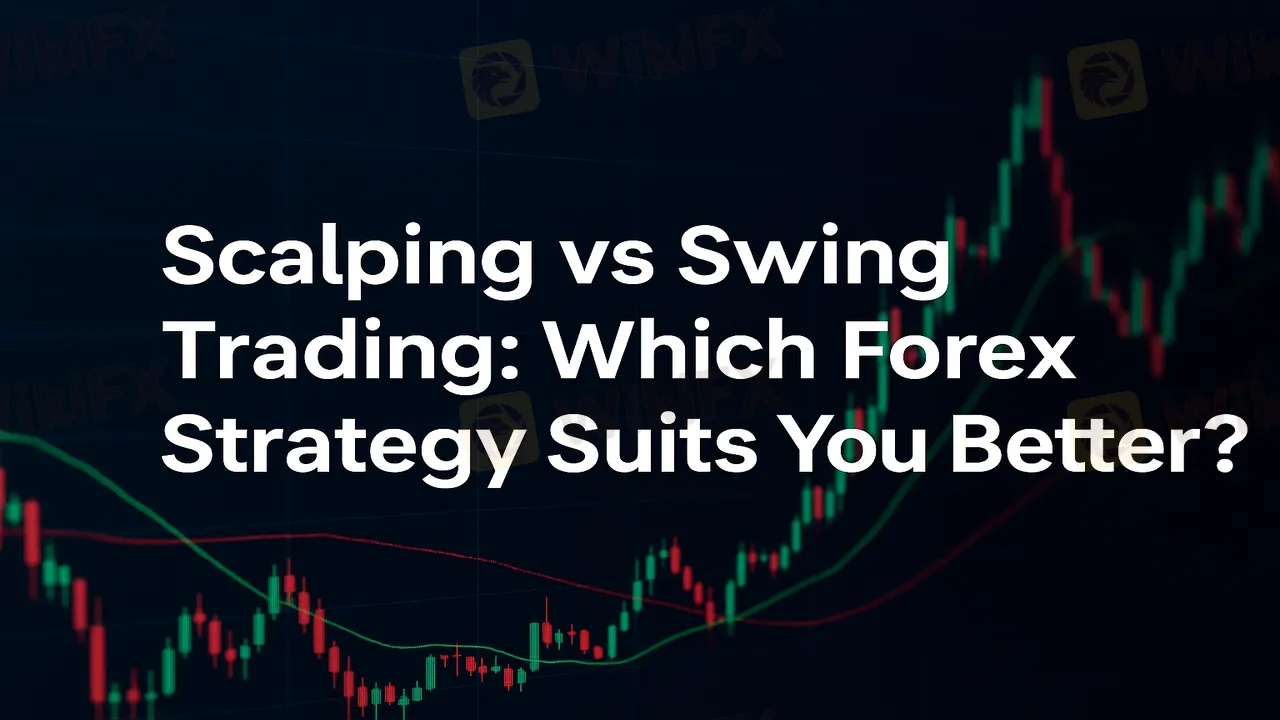简体中文
繁體中文
English
Pусский
日本語
ภาษาไทย
Tiếng Việt
Bahasa Indonesia
Español
हिन्दी
Filippiiniläinen
Français
Deutsch
Português
Türkçe
한국어
العربية
Scalping vs Swing Trading: Which Forex Strategy Suits You Better?
Abstract:Confused about which to choose between scalping and swing trading? The basic difference between the two is this - While scalping involves quick trades meant to earn small profits, usually within minutes, swing trading focuses on larger price movements over a few days or even weeks. Keeping this in mind, we have shared the definition of scalping and swing trading, their pros and cons, and other critical insights. Keep reading to learn about which is better - forex scalping vs swing trading.

Confused about which to choose between scalping and swing trading? The basic difference between the two is this - While scalping involves quick trades meant to earn small profits, usually within minutes, swing trading focuses on larger price movements over a few days or even weeks. Keeping this in mind, we have shared the definition of scalping and swing trading, their pros and cons, and other critical insights. Keep reading to learn about which is better - forex scalping vs swing trading.
Defining the Scalping Trading Method
Scalping is a type of forex trading method that aims to earn profits from small price fluctuations. Contrary to other market participants who keep positions open for a long time, scalpers will open and close positions within a few minutes. The basic idea behind it is to catch market price movement, allowing traders to widen their potential gains. As a scalper, you can thus look forward to a quick scalping indicator - technical analysis - with a short time horizon. While this trading style may seem like regular intraday trading, there is a crucial difference in the time needed to execute these two trades. Scalping happens within a few minutes, whereas intraday trading can take one whole day before the market closes.
A Quick Look at Scalping Trading Features
Short Time Frames
Scalpers eye trading opportunities within shorter time frames, say 1-5 minute charts.
Frequent Trades
As a scalper, you trade frequently to earn small profits throughout the day.
High Leverage
Scalpers usually use increased leverage to enhance small gains from price changes.
Technical Indicators
You can always glance at technical indicators such as the Stochastic Oscillator, Relative Strength Index (RSI), and Moving Average Convergence Divergence (MACD) before identifying trade setups. At the same time, you can look forward to support and resistance levels to decide on your trading moves.
What are the Advantages of Scalp Trading?
Quick Profits
Scalping enables traders to earn quick profits from small price movements, should these be in their favor.
Minimal Market Exposure
Since scalp trading remains for an extremely short term, the exposure to unexpected market events remains considerably less.
Massive Opportunities
You get extensive daily trading opportunities as trades become frequent throughout the day.
Limitations Associated with Scalping
A Potentially Stressful Trading Experience Awaits
As a trader, you need to constantly focus on the market movement and make quick decisions, which can turn out to be a stressful experience if you are not prepared for it.
High Transaction Costs
Since scalping involves frequent trading, it raises your overall transaction costs with brokerage fees and commissions. This can reduce your overall gains.
The Risk of Big Losses
As a scalper, you aim for small profits. However, there is always the risk of a few big losses wiping out your gains if you fail to manage trades.
Overview of Swing Trading
Swing trading allows traders to earn profits by holding their positions for a few days or weeks. Unlike scalping or day trading, where individuals open and close positions within a day, swing trading allows traders the time needed to achieve their profit targets. Traders adopting this strategy unleash medium-term trading opportunities and benefit from price swings. Swing traders will usually look forward to fundamental and technical analysis to identify potential market setups. These traders invariably analyze various swing trading patterns and swing trading indicators, such as RSI, moving averages or Fibonacci retracements, to estimate the market movement. The ideal time for swing trading usually involves the daily or 4-hour charts. Using these charts, traders can identify trends and key support and resistance levels.
Swing Trading Features at a Glance
Holding Period
Traders hold trades for a few days to several weeks, considering the nature of market movement.
Wider Stop Losses
As the trades remain open for a longer timeframe, swing traders seize the opportunity of wider stop losses. As a result, they find more space to deal with short-term currency pair price fluctuations.
Lower Leverage
Swing traders usually opt for lower leverage compared to scalpers, allowing the former to manage risks better.
Swing Trading Benefits
More Time for Decisions
As opposed to scalpers, swing traders find more time to analyze market movements before executing trades. As a swing trader, one does not need to spare time for every single market movement. It thus reduces stress from your trading.
Flexible Schedule
As the trading does not require constant market monitoring, swing traders can plan their trades and do other work to meet their busy lifestyle needs.
Potentially Greater Gains
Swing traders look to capture larger currency pair price movements to earn higher profits compared to small gains accumulated through scalping.
Pitfalls of Swing Trading
Exposure to Overnight Risk
Swing trading involves keeping positions open for a longer timeframe, exposing investments to overnight market news or events that may adversely affect your positions.
Not for Those Wanting Quick Bucks
Swing trading is not for those who want to earn within minutes. As a swing trader, you need great discipline and patience to unleash the right opportunities.
More Capital Requirements
As the timeframe remains longer and stop losses remain wider, swing traders may need more capital to deal with potential drawdowns, especially in a volatile market scenario.
So, What Should You Choose - Scalping vs Swing Trading?
Both scalping and swing trading have their own appeal, and the right choice depends entirely on your trading personality, time availability, and risk tolerance.
If you prefer quick decision-making, thrive in fast-paced environments, and can handle the pressure of constant monitoring, scalping may fit your style. It offers frequent opportunities but demands intense focus and emotional control.
On the other hand, if you value patience, strategic planning, and prefer to analyze market trends over time without staring at the charts all day, swing trading might be the better option. It allows for more flexibility and potentially higher profits, though it carries overnight risks.
In short, theres no universally “better” approach — the winning strategy is the one that aligns with your temperament, trading goals, and time commitment. Many traders even experiment with both styles before deciding which one complements their strengths.
We hope you can now make a decision on scalping vs swing trading.
Want more insights on forex trading strategies (Scalping, Swing Trading & More)? Be with us on WikiFX Masterminds.
Here are the steps to join it -
1. Scan the QR code placed right at the bottom.
2. Download the WikiFX Pro app.
3. Afterward, tap the ‘Scan’ icon placed at the top right corner
4. Scan the code again.
5. Congratulations on joining the group.

Disclaimer:
The views in this article only represent the author's personal views, and do not constitute investment advice on this platform. This platform does not guarantee the accuracy, completeness and timeliness of the information in the article, and will not be liable for any loss caused by the use of or reliance on the information in the article.
Read more

How to Become a Profitable Forex Trader in Pakistan in 2025
If you want to enter the forex market in Pakistan and achieve success, earning consistent profits and excelling in trading, then you should check out this “How to Become a Profitable Forex Trader in Pakistan in 2025” article. You will wonder why you need to do this? The answer is simple: this article covers all the essential topics such as Forex Trading in Pakistan, and ways to learn Forex Trading in Pakistan, even if you are a native speaker and want to learn forex trading in Urdu. This article talks about that too. So, if you want to succeed in the forex market in 2025, read this article sincerely.

Alpha FX Allegations: Traders Claim Account Blocks, Withdrawal Denials and Security Breaches
Is trading with Alpha FX fraught with too many errors and scams? Have you seen your forex trading account blocked after requesting fund withdrawals with the broker? Invested a heavy amount, but finding it hard to withdraw the sum? Have you seen domain changes while attempting an Alpha FX login? These issues have become typical for Alpha FX traders, with many of them sharing their frustration online. In this Alpha FX review guide, we have shared some trading complaints against the UK-based forex broker. Read on!

In-Depth Review of MH Markets Trading Conditions and Leverage – An Analysis for Experienced Traders
For experienced traders, selecting a broker is a meticulous process that extends far beyond marketing claims and bonus offers. It involves a granular analysis of the core trading environment: the quality of execution, the flexibility of leverage, the integrity of the regulatory framework, and the suitability of the conditions for one's specific strategy. MH Markets, a broker with a 5-10 year operational history, presents a complex and multifaceted profile that warrants such a detailed examination. This in-depth review dissects the MH Markets trading conditions and leverage, using primary data from the global broker inquiry app, WikiFX, to provide a clear, data-driven perspective. We will analyze the broker's execution environment, account structures, and regulatory standing to determine which types of traders might find its offering compelling and what critical risks they must consider.

MH Markets Commission Fees and Spreads Analysis: A Data-Driven Breakdown for Traders
For any experienced trader, the long-term viability of a brokerage partner hinges on a delicate balance of trust, execution quality, and, critically, cost. Trading fees, both direct and indirect, can significantly erode profitability over time. This makes a granular understanding of a broker's cost structure not just beneficial, but essential. This in-depth analysis focuses on MH Markets, breaking down its commission fees, spreads, and other associated costs to provide a clear, data-driven perspective for traders evaluating this broker for their long-term strategies. Drawing primarily on verified data from the global broker inquiry platform WikiFX, alongside other public information, we will dissect the MH Markets spreads commissions cost structure. We aim to move beyond marketing claims and uncover the practical, real-world costs of trading with this broker, helping you determine if its pricing model aligns with your trading style and financial goals.
WikiFX Broker
Latest News
The 350 Per Cent Promise That Cost Her RM604,000
In-Depth Uniglobe Markets Commission Fees and Spreads Analysis – What Traders Should Really Know
WikiFX's New Evaluation of ATM Capital LTD: Does its License Protect the Arab Investor?
Is Axi Legit? A Data-Driven Analysis of Its Regulatory Standing and Trader Feedback
How a Fake Moomoo Ad Led to the “New Dream Voyage 5” Scam
FXPesa Review: Are Traders Facing High Slippage, Fund Losses & Withdrawal Denials?
Trive Investigation: High Score, Hidden Risk - The Profit Paradox
CMC Markets Australia Revenue Surges 34%, But High-Net-Worth Clients Face Tax Phishing Threat
"Just 9 More Lots": Inside the Endless Withdrawal Loop at Grand Capital
GCash Rolls Out Virtual US Account to Cut Forex Fees for Filipinos
Currency Calculator



